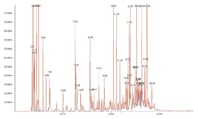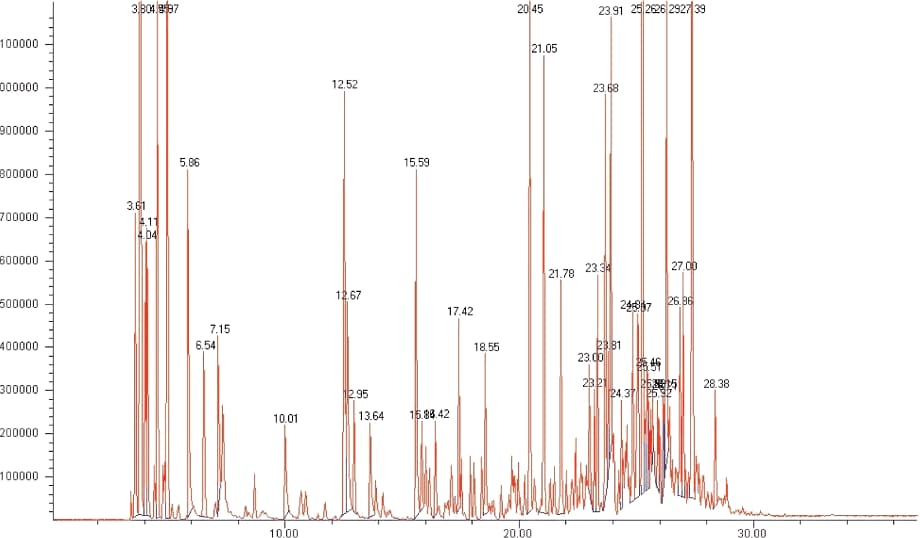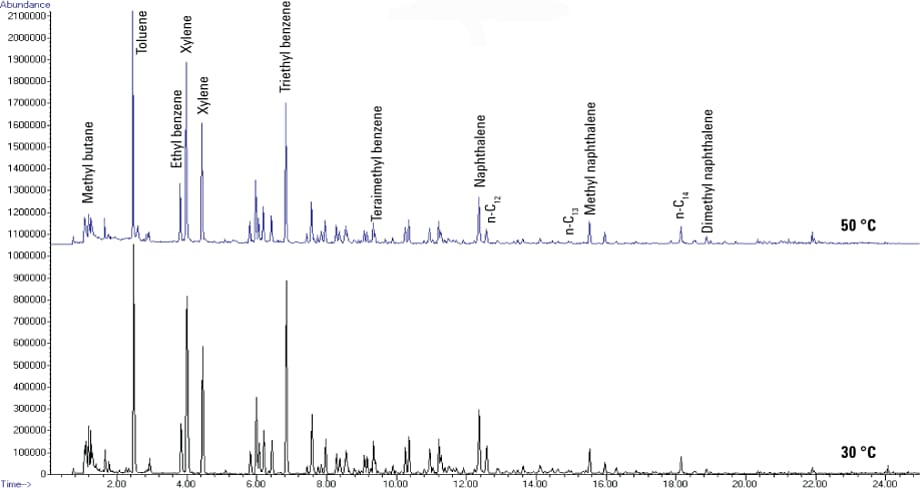Access Agilent eNewsletter, March 2014
>> Update My Profile | Subscribe to Access Agilent | Article Directory

Complete, quick, and easy solutions for soil and landfill gas analysis
By Laura Provoost
Agilent GC Product Manager
There are numerous health hazards associated with toxic air contaminants, as well as significant monitoring difficulties due to particle size, scarcity, and matrix complexity. As regulations have become more stringent, it is important that you can quickly and easily gather uniform samples and execute multiple testing methods to detect an increasing list of harmful substances.
The Agilent 7890B GC with the 5977 MS portfolio along with the Markes Unity Thermal Desorber provides a complete air analysis solution to meet these challenges. Agilent solutions for analysis of contaminated air released from landfill and soils are explored in the following two examples.
 Enlarge
Enlarge
Figure 1. 100 mL landfill gas sample analyzed by GC/MS with an Agilent J&W DB-VRX GC column.
Easy sampling, analysis, identification, and confirmation of landfill gases
As a consequence of content and decomposition processes, landfill sites containing domestic and commercial waste produce a variety of odorous and toxic volatile organic compounds (VOCs). In the European Union, landfill sites must be classified as either hazardous, non-hazardous (municipal), or inert, and include regulations calling for monthly monitoring. In addition to 20 identified target compounds, landfill gas can contain several hundred VOCs and other gases. With this first example of thermal desorption – gas chromatography – mass spectrometry (TD GC/MS), a complete analysis method is required that enables sampling, analysis, and positive identification of the presence or absence of every compound.
We used inert coated, two-bed sorbent tubes from Markes International to take small (100 mL) samples of landfill gas. The tubes were dry purged before analysis to remove excess water. Using the power of an Agilent J&W DB-VRX GC column and Agilent GC/MS ChemStation, the presence or absence of target compounds (Figure 1) was confirmed using a Retention Time Locked screenable database. This multiple level of identification confirmation is necessary when analyzing such complex mixtures as those found in landfill gas sites. Additional confirmatory techniques can also be used for identification, including use of different library search algorithms, such as AMDIS and NIST.
 Enlarge
Enlarge
Figure 2. Gasoline vapor collected from wet sand samples at 30 °C and 50 °C using soil gas tubes, and analysis on an Agilent J&W VF-5ms column.
Quickly identify risk to human health from fuel-contaminated soil
When investigating fuel-contaminated sites, soil gas measurements are used to assess the potential risk to human health from vapor intrusion into nearby buildings and to identify fuel sources for mitigation and liability management. For this analysis we used soil gas tubes, containing Tenax TA at the sampling end and Carbotrap X or 5TD at the other, which are very suitable for sampling soil gas contaminated with a range of petroleum fuels under worst-case real-world conditions of humidity and surface temperature. Both lighter hydrocarbons and polyaromatic/longer chain hydrocarbons were detected, confirming the results shown by Hayes et al. (2007) [1] that sorbent tubes provide a representative TPH profile of light and middle distillate fuels in soil gas. Figure 2 shows just one of the soil/fuel combinations tested, in this case gasoline vapor from wet sand at two temperatures. GC/MS was accomplished using an Agilent J&W VF-5ms GC column.
The soil gas tubes are also compatible with complete quantitative recovery of even the heaviest fuel components, permitting cost-effective immediate repeat use without additional conditioning.
Combined solutions for effective air analysis
Quickly detecting health hazards derived from toxic air contaminants, while achieving compliance with ever more stringent regulations, has become a global priority. Agilent GC/MS instruments and columns, along with complementary pre-configured analyzers, help your labs perform effective air sampling, desorption, testing, and data analysis, while achieving lower detection limits. Learn more about Agilent’s air analysis solutions, and order your copy of our Air Monitoring Poster (Agilent publication number 5991-2380EN).
Acknowledgment
We thank Markes International Ltd for use of the chromatograms and supporting text.
Reference
- H. C. Hayes, D. J. Benton, S. Grewal, N. Khan. Evaluation of sorbent methodology for petroleum impacted site investigations. Proceedings of the Air and Waste Management Association Conference on Vapor Intrusion. (September 2007).
>> Update My Profile | Subscribe to Access Agilent | Article Directory

